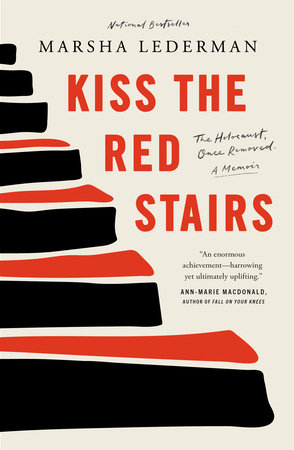READERS GUIDE
Reader’s Guide Questions for Kiss the Red Stairs1. Lederman often forms her thoughts and reflections as questions, many of which she does not, and cannot, have answers for based on the lack of information she has about her family’s history. Did her questioning inspire reflections of your own?
2. “In Canada today, immigrants are celebrated—at least in the crowds I run with. Things weren’t quite that way in the 1970s (18).” Do Lederman’s notes on immigrants—in this case, specifically Jewish immigrants—align with your understanding of the world’s perception of Canadian culture? Why or why not?
3. Journalist Andrea Tebart, who Lederman and her sisters hired to help research their parents, says “as far as I personally know about traumas, . . . they cannot be deleted, but ‘only’ overwritten by good things (87).” Compare this statement to what Lederman’s friend tells her: “your ancestors are singing for you, crying out to you, they are supporting you, they are sending you strength (7).” How has intergenerational trauma impacted Lederman’s life? And what are examples of the strength she has inherited from her family?
4. Through her research into children of Holocaust survivors, Lederman comes to this conclusion: “I experience the world like a survivor (121).” How does her research help Lederman understand herself, the trajectory of her life, and her son Jacob with more clarity?
5. The article “The Collision”—written from Lederman’s discussions with German-Canadian artist Fred Herzog— garnered hatred and animosity from the public, much of it involving Holocaust denial. How does Lederman go on to challenge the notion that there is only “one” form of such denial?
6. What does Lederman have to say about the importance of journalism throughout history—specifically between World War II and the present day? What does Lederman also note about the “evil agendas (184)” of journalism, and the dangers of fake news?
7. “Sometimes a single conversation can change your life. Or, the way you see life (189).” Lederman has many conversations in this memoir—and, overall, carries out an important conversation with herself. Highlight examples of conversations that impacted your reading.
8. Lederman’s research trip to New York and Washington, D.C., helps her shed light on her family’s history; she also reflects on a different journey, one she took twenty years prior, to Poland. How did these experiences, though years apart, help her with her overall writing project?
9. We learn of the importance of the red stairs—and the kiss—that make up the title of this memoir on page 296. Discuss the importance of these stairs, and why Lederman refers to her desire to see them as a “pilgrimage.”
10. “I had built this. I understood what a beautiful achievement this was. I had built this community, and this community had come and rescued me, at the most difficult times (340).” Lederman has this realization after her and her son’s cat, Lucy, goes missing. What about this event led her to this realization? Why do you think it was this moment?
11. “I had found a way to tell [my son] this most difficult of stories. By focusing on the strength and the light—in his namesake, in me, in him (364).” Discuss the importance of storytelling touched upon by this statement—in particular, the telling of our family’s stories, and, ultimately, our own.

